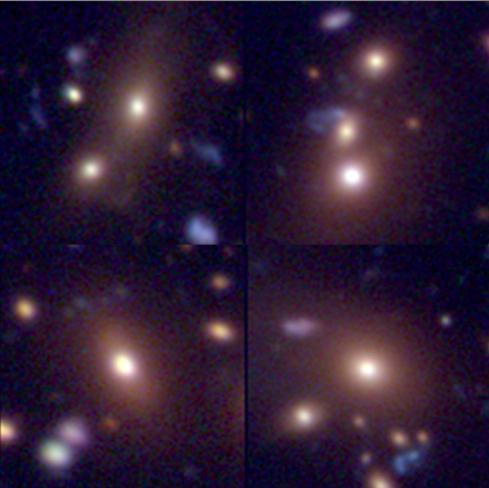Forming galaxies like?
Astronomers have recently discovered the integration process of many large galaxies about 4 billion years ago. This discovery is made possible by combining the use of terrestrial telescopes and the best space to reinforce the theory of the formation of the galaxy.
How is the galaxy formed? The widely accepted answer to this basic question is the 'step-by-step formation ' model, a process in which small galaxies merge to form a large galaxy. The formation of the galaxy is similar to the fact that many streams form rivers, and many rivers continue to form larger rivers. The theoretical model predicts that galaxies have grown to large sizes through multiple fusion in their lifecycle. But when does this unified phenomenon end? When does the big galaxy reach its maximum size?
To answer those questions, astronomers studied large galaxy clusters, or a cosmic city that contained many galaxies. Kim-Vy Tran of the University of Zürich, Switzerland, the leader of the study, said: 'Whether the brightest galaxies have grown significantly in size glass over the past few billion years is controversial. Our observations show that at this time, those galaxies increased by 50% of their size. '
Astronomers use a combination of telescopes and devices, including the ESO's Super Telescope (VLT) and the Hubble Space Telescope, to study the galaxies located in detail. 4 billion light years. These galaxies reside in an unusual system consisting of four galactic groups forming a cluster.
Specifically, the team took pictures with VIMOS and spectroscopy with FORS2, both devices on the VLT. From the observations collected, they were able to identify a total of 198 galaxies belonging to these 4 groups.
The brightest galaxy in each group contains between 100 and 1,000 billion stars, the same number as the largest galaxies in the cluster.

Gather color images of the brightest galaxies of the four groups spaced 4 billion light-years apart.These galaxies are arranged in increasing mass of stars, for example in the chronological order (top left, top right, bottom left, lower right).(Photo: ESO).
Tran said: 'The most amazing thing is that three of these four groups, the brightest galaxy usually has another bright galaxy companion. Such pairs of galaxies are unified systems'.
The brightest galaxy in each group can be arranged in time series to show that galaxies have grown in size over the past 5 billion years. It seems that because of 'eating' many galaxies recently, the brightest galaxies increase 50% in size .
The discovery has given considerable persuasion to the theory of 'step-by-step formation', as demonstrated in the merging of galaxies and galaxy clusters.
Tran concludes: 'Stars in these galaxies are old and so we conclude that the recent merger does not create any new generation of stars. Most stars in these galaxies were born at least 7 billion years ago. '
The team includes Kim-Vy H. Tran (Institute of Physical Physics, Zurichm University, Switzerland), John Moustakas (New York University, USA), Anthony H. Gonzalez and Stefan J, Kautsch (Great Florida, Gainesville, USA), Lei Bai and Dennis Zarisky (Steward Observatory, University of Arizona, USA).
Refer:
Tran et al.The Late Stellar Assembly of Massive Cluster Galaxies via Major Merging.The Astrophysical Journal, 2008;683 (1): L17 DOI: 10.1086 / 591422
- Huge heat destroys the process of forming galaxies in the universe
- The mystery of the dead galaxies
- New history page about black holes (part III)
- Detecting a group of 'ghost galaxies'
- Discover 'living fossil' galaxies in the universe
- Discover the birth of ancient galaxies
- Galaxy Fairy Women will swallow our Milky Way?
- The Milky Way is lighter than we thought
- Stunned disclosure of technology to identify cosmic galaxies
- Clash between two galaxies
- New recipe for dwarf galaxies
- Close up of galactic conflict
 Van Allen's belt and evidence that the Apollo 11 mission to the Moon was myth
Van Allen's belt and evidence that the Apollo 11 mission to the Moon was myth The levels of civilization in the universe (Kardashev scale)
The levels of civilization in the universe (Kardashev scale) Today Mars, the sun and the Earth are aligned
Today Mars, the sun and the Earth are aligned The Amazon owner announced a secret plan to build a space base for thousands of people
The Amazon owner announced a secret plan to build a space base for thousands of people